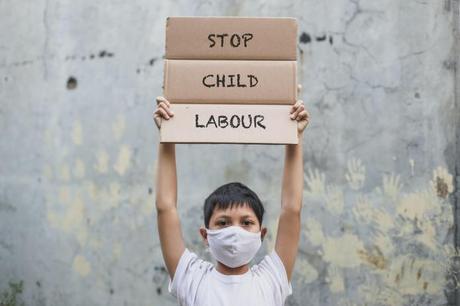Childhood is the most joyous thing in a person's life; it is full of innocence, love, purity, and joy like a blossoming flower in the garden of humanity. The beauty of childhood is a privilege that not all children get to enjoy. Due to poverty, rising economic insecurity, migration, a lack of respectable prospects, and a lack of social security, a large number of children are deprived of childhood and the needs of life, which ultimately exposes them to child labour that is exploitative.
Child labour is defined by the ILO (Indian Labour Organization) as work that robs children (or anybody under the age of 18) of their childhood, their potential, and their dignity, and that is detrimental to their physical and/or mental development.* depriving them of the opportunity to attend school
* obliging them to leave school prematurely
* requiring them to attempt to combine school attendance with excessively long and heavy work.
According to the Census of 2011, 10.1 million children between the ages of 5 and 14 worked in India overall. This threat is not just an issue in India; it is present all across the world. Children who work are abused physically as well as mentally. They are susceptible to child trafficking, prostitution, forced marriages, sexual exploitation, and illnesses. Due to the fact that children are our future generation, child labour and education deprivation represent challenges to the country's economy. Because many families were forced to live in lockdown due to the COVID-19 pandemic and because many parents were unable to find work, many children were pushed into child labour to help their families with their basic requirements.
Causes of Child Labour in India
The main causes of child labour in India are:


- Over-Population - The population of the country is more in comparison to the job opportunities available leading to poverty and exploitation of children to work.
- Illiteracy - This is one of the biggest causes because If a child is unable to gain education due to financial or social reasons, he/she is more likely to opt for working at wages and helping the family.
- Poverty - To overcome the financial crisis and poverty, parents are forced to make their children work for money & unplanned Urbanization is another cause.
- Orphans - Child labour is more likely to affect orphans. The government needs to make new arrangements for orphans so that they can receive an education and avoid having to start working at a young age to make ends meet.
- Debt trap -In some circumstances, a family's debt or financial situation forces the selling of its children as slaves, which results in child labour. Since the labour salary is so low, they are compelled to let their kids work in order to raise the family income.
Child Labour: Constitutional And Legal Provisions
The dream of an educated, independent youth with a sense of personal freedom was what the constitution's framers envisioned. The Constituent Assembly created various provisions and articles to safeguard children's rights. Any form of forced labour is forbidden by the Indian Constitution's Article 23. According to Article 24, a youngster under the age of 14 cannot be hired to conduct any hazardous work. "The health and strength of workers, men and women, and the tender age of children are not abused," declares Article 39.
In a similar vein, the Child Labour Act (Prohibition and Regulation) of 1986 forbids children under the age of 14 from working in risky environments.
Children are now enrolled in schools and rural families have access to guaranteed wage jobs (unskilled) because of policy measures including MGNREGA 2005, the Right to Education Act 2009, and the Mid Day Meal Program.
Additionally, the Indian government has shown its commitment to the abolition of child labour, including that involved in dangerous vocations, by ratifying ILO Conventions Nos. 138 and 182 in 2017.
Also read Clean India Green IndiaAssociated Issues With the Child Labour


As was said above, there are a number of variables that contribute to child labour and exploitation, such as poverty, social norms that support it, a lack of opportunity for adults and teenagers to find respectable jobs, migration, and emergencies. These elements not only contribute to societal injustices that are exacerbated by prejudice, but they are also a result of them.
As well as posing a threat to national economies, child labour and exploitation has serious detrimental short- and long-term effects on children, including the denial of education and the deterioration of their physical and mental health. Although it is against the law, child labour is nonetheless prevalent throughout India in a number of unregulated sectors, including agriculture, fisheries, carpet weaving, garment manufacturing, and brick kilns. Children are still employed in hidden types of child labour, such as domestic help, despite the fact that rates of child labour have decreased over the past few years. The work they do might not seem immediately harmful, but it might have long-term, disastrous effects on their education and skill development.
Thus, they will have the chance to escape the vicious cycle of destitution, inadequate education, and subpar employment in the future. Child maltreatment is always a byproduct of child trafficking, which is also connected to child labour. Children who have been trafficked may be forced into prostitution, forced into marriage, or unlawful adoption; they may also be made to work as housemaids or beggars or perform cheap or unpaid labour; they may also be recruited into armed groups.
World Day against Child Labour
World Day Against Child Labour was introduced in 2002 by the International Labour Organisation. It is celebrated on June 12th every year across the world.
In 2022, the day was celebrated jointly by the Global March Against Child Labour and the International Partnership for Cooperation on Child Labour in Agriculture (IPCCLA). The theme for 2022 was "Universal Social Protection to End Child Labour."
How to tackle the issue of Child Labour-
The Panchayat can play a significant role in reducing child labour because over 80% of child labour in India occurs in rural regions. Panchayat should raise awareness of the negative impacts of child labour in this environment, nudge parents to enrol their kids in school, and Create a setting where kids aren't working and are instead enrolled in school. Make sure there are enough facilities for kids in schools, Inform business owners of the laws against child labour and the consequences of breaking these laws.
Activate the Balwadis and Aanganwadis in the village to prevent working mothers from entrusting their older siblings with the care of the younger children.
Encourage village education committees (VECs) to upgrade school facilities.
Through comprehensive strategies that improve child protection systems, alleviate poverty and inequality, increase access to and the quality of education, and organise public support for upholding children's rights, child labour and other types of exploitation can be avoided. Children have the potential to make a substantial contribution to both avoiding and combating child labour. They are crucial players in the protection of children and can offer insightful information about how they see their role and what they anticipate from the government and other parties.
To ensure that no one is denied education and information, the government must implement harsher rules and penalties against child labour and make primary education free for all.
Conclusion
Children should be in schools, not at jobs. Children who work as children are denied the opportunity to attend school, which perpetuates intergenerational cycles of poverty. Child labour poses a significant obstacle to education, hurting both attendance and academic achievement. It is a threat that needs to be eliminated immediately.

